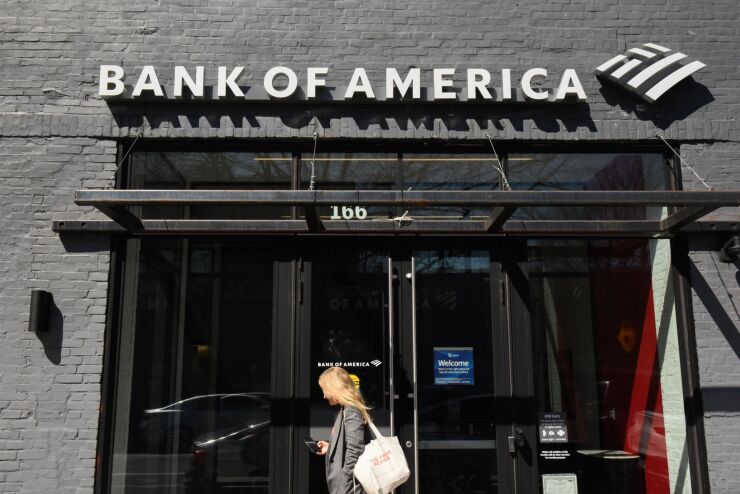
As virtual assistant adoption grows, card issuers are building user experience flows that resemble intelligent search tools.
A case in point is Bank of America, which is building a user experience flow reminiscent of an online search by putting the conversational interface at the top of the app. To drive further adoption, the bank is improving the precision and breadth of answers to client questions.
"We're talking about thousands of small, iterative improvements," since Erica was launched in 2018. A lot of the work has been geared toward ensuring responses to questions correctly match the intent of client questions, said Jorge Camargo, a managing director at Bank of America responsible for the mobile app, online banking and Erica.
"One of the big enhancements we made is integrating Erica into the masthead, the header of the experience," Camargo said. "That's tied to clients increasingly also wanting to not just ask the question, but also potentially use Erica akin to a search engine."

Bank of America's virtual assistant, Erica, launched in 2018, is widely seen as an industry leader. By the fourth quarter of last year, it had 18.5 million active users, making up 49% of the bank's active mobile banking user population of 37.9 million people.
The bank's efforts to improve Erica's user interface and capabilities come as a growing number of consumers are relying on virtual assistants. In an October 2023 Corporate Insight survey of 3,300 consumers on their use of credit card issuer digital platforms, 24% of mobile app users said they used a virtual assistant in the past 6 months — up from 4% in October 2019. For the purposes of the study, mobile users were defined as people who have used their card issuer's mobile app at least once in the past month.
Corporate Insight researchers, in tests they conducted, singled out three card issuers' virtual assistants for their leading-edge capabilities, including those from Bank of America, American Express and Discover. Virtual assistants from these firms could handle tasks that include offering preset topics to start a conversation; allowing users to initiate service requests or transactions; and providing in-assistant account information.
In Bank of America's case, the number of active Erica users has steadily increased over the past three years, after it more than doubled between 2020 and 2021. The uptick in virtual assistant adoption across the industry, according to James McGovern, vice president of research and consulting at Corporate Insight, can be attributed to bank marketing efforts, improved in-app capabilities — including getting more questions answered inside the virtual assistant interface instead of having to go to the mobile app or website — and, more recently, to interest in generative AI tools. Bank of America also said its marketing efforts and in-app capabilities have driven adoption.
"There were much more rudimentary tools available five or ten years ago, so I think people are coming back to it and a lot of that has to do with this broader interest that's been driven by ChatGPT, [Google's] Gemini and all the buzz about AI and virtual assistants," said McGovern.
Generative AI and customer service
The popularity of generative AI tools like ChatGPT and Google's Gemini is shaping customers' virtual assistant expectations, including the expectation to be able to carry out tasks within the assistant interface and a user experience that resembles more of a search engine instead of a static chatbot, industry experts and banks say.
Bank of America has not yet incorporated generative AI — a type of AI that can generate new content based on what it learns — into Erica, but the bank is currently exploring how generative AI might improve the customer experience.
It's not alone: In a 2023 KPMG survey, 62% of financial services executives
"Like probably I imagine every single company out there, we are exploring internally, what are the potential uses of not just generative AI but a tremendous outburst of new AI improvements in the machine learning space, and the machine vision space, and seeing what makes sense for us to incorporate," Camargo said. "The process that we follow … it's always an evaluation of that technology, followed by internal pilots or pilots that would leverage our internal associates first, before we roll out anything to our clients."
Incremental improvements
The recent interface change Bank of America made to Erica — putting the conversation bar at the top of the app — is part of a series of incremental improvements to keep up with user expectations. It also more closely resembles how search tools work online, including the interface of popular generative AI tools.
"Most chat agents that are in the marketplace … if you hold your phone, the entry point into that assistant is a floating bubble in the lower right hand part of the page," Camargo said. "Erica is now more of the search bar at the very top of the header page, and there's an icon that can prompt Erica to start a conversation there. This is an example of something we learned through research and experience design." (People can ask Erica questions; Erica can also proactively share insights.)
On the functional side, Bank of America has built up Erica's knowledge base and gotten better at personalizing interactions, Camargo said. For clients with retirement plans, for example, it can address not only basic questions, but queries relating to rebalancing or changing contribution rates. The bank has also worked to embed many popular tasks — including me-to-me money transfers and peer-to-peer payments. For more complex queries such as wires or bill payments, Erica will take users back to the mobile app to complete the transaction. Proactive insights — including reports of spending patterns and recurring charges — are popular among consumers, said Camargo.
Other banks are also looking to beef up insights capabilities in their virtual assistant interfaces. Wells Fargo's assistant, Fargo, launched in 2023, includes a personalized spending tracker and subscription insights, as well as tax refund and government deposit alerts. It can also alert customers of upcoming activity and when a customer's balance is about to hit zero based on historical patterns.
Confronting previous experience bias
Leading-edge virtual assistants have been increasingly incorporating the ability for customers to carry out transactions and other financial tasks inside the virtual assistant interface, instead of being directed to a website or app. But having to leave the app to review information or carry out a task can be problematic for some consumers, said Julianna Sansevero, a senior analyst at Corporate Insight.
"There are still some firms that still just provide text-based instructions on where to find things, which obviously can cause problems if you have to leave the assistant architecture," she said.
One of the key roadblocks standing in the way of further adoption might be the last negative experience a consumer might have had with a virtual assistant years ago.
Bank of America is giving its "erica" chatbot more time to learn the nuances of language and banking basics. A profanity filter is one recent addition.
"This experience stems from having to deal with the earlier versions of these assistants …where you have to go through a series of prompts. It's quite frustrating," said Gadjo Sevilla, a senior analyst at Emarketer. The introduction of generative AI-powered assistants — which could be piloted by some institutions as early as this fall — could go a long way in driving up adoption.
In the interim, banks say they need to be aware of the impact of generative AI tools on customer expectations.
"As virtual assistants continue to penetrate the market and consumers see tangible benefits from AI interactions, expectations for virtual assistants will continue to grow exponentially," said Michelle Moore, head of consumer and wealth and investment management digital at Wells Fargo and former Bank of America executive who led the launch of Erica in 2018. "When consumers ask their virtual assistant a question, they expect a humanlike response. Anything less can be attributed to a sub-par experience and hinder adoption."






